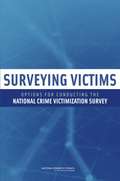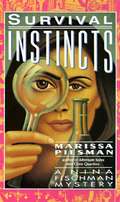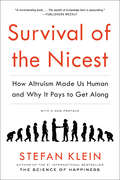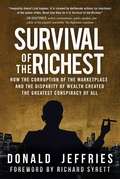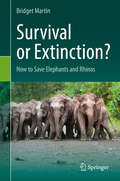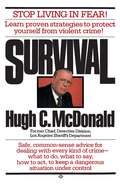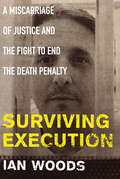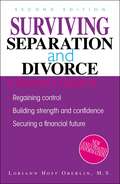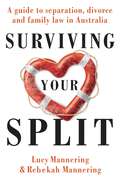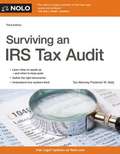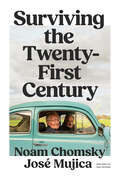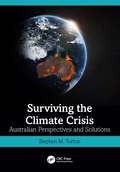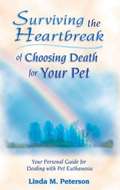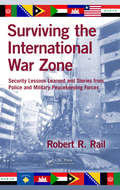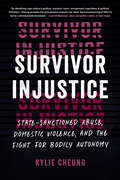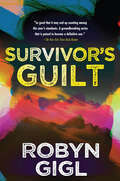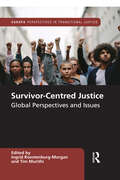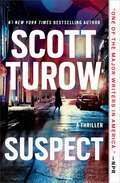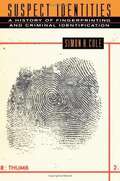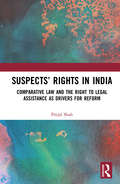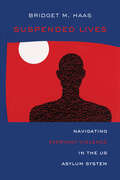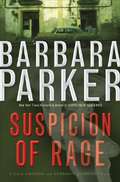- Table View
- List View
Surveillance: A Key Idea for Business and Society (Key Ideas in Business and Management)
by Graham SewellBeing watched and watching others is a universal feature of all human societies. How does the phenomenon of surveillance affect, interact with, and change the world of business? This concise book unveils a key idea in the history and future of management. For centuries managers have claimed the right to monitor employees, but in the digital era, this management activity has become enhanced beyond recognition. Drawing on extensive research into organizational surveillance, the author distils and analyses existing thinking on the concept with his own empirical work. Drawing together perspectives from philosophy, cutting-edge social theory, and empirical research on workplace surveillance, Surveillance is the definitive introduction to an intriguing topic that will interest readers across the social sciences and beyond.
Surveying Victims: Options for Conducting the National Crime Victimization Survey
by National Research Council of the National AcademiesThe National Academies Press (NAP)--publisher for the National Academies--publishes more than 200 books a year offering the most authoritative views, definitive information, and groundbreaking recommendations on a wide range of topics in science, engineering, and health. Our books are unique in that they are authored by the nation's leading experts in every scientific field.
Survival Instincts
by Marissa PiesmanThis is the latest mystery featuring Nina Fischman, that witty Upper West Side lawyer who's slipping out of her thirties, still on a diet and without a boyfriend. Just three months after Nina gave up everything to follow her boyfriend Jonathan to California, she is back in New York--single, jobless, living with her mother and ready to start all over again. But the doldrums quickly subside when her brother-in-law, the dermatologist, becomes a murder suspect. Ken was involved in a real estate deal with Andy, the dead man, a scientist whose researches involved animal experimentation, and he seems to have been poisoned--just what Nina needed. She and her equally irrepressible mother Ida can't keep their noses out of trouble and start their own investigation. Whodunit? The dead man's striking wife? Andy's lab colleagues? The animal activist? Ken? And can Nina figure it all out as the clues fall into place? You bet.
Survival of the Nicest: How Altruism Made Us Human and Why It Pays to Get Along
by Stefan KleinAward-winning, international bestselling science writer Stefan Klein explores the benefits of altruism on humanity in Survival of the Nicest.The phrase “survival of the fittest” conjures an image of the most cutthroat individuals rising to the top. But Stefan Klein, author of The Science of Happiness, makes the startling assertion that altruism is the key to lasting personal and societal success. In fact, altruism defines us: Natural selection favored those early humans who cooperated in groups, and with survival more assured, our altruistic ancestors were free to devote brainpower to developing intelligence, language, and culture—our very humanity. Klein’s groundbreaking findings lead him to a vexing question: If we’re really hard-wired to act for one another’s benefit, why aren’t we all getting along? He believes we’ve learned to mistrust our instincts because success is so often attributed to selfish ambition, and with an extraordinary array of material—current research on genetics and the brain, economics, social psychology, behavioral and anthropological experiments, history, and modern culture—he makes the case that generosity for its own sake remains the best way to thrive.“Stefan Klein, an enticing storyteller, marshals the evidence for the value of altruism—not only to one’s family but, much more interestingly, to one’s self and one’s tribe. Altruism is truly contagious!” —Roald Hoffman, Nobel Laureate“A scholarly tour de force about why generosity makes good sense, Survival of the Nicest is also compulsively readable. Klein argues convincingly that helping others is one of the best things we can do for ourselves.” —Elizabeth Svoboda, author of What Makes a Hero?: The Surprising Science of Selflessness
Survival of the Richest: How the Corruption of the Marketplace and the Disparity of Wealth Created the Greatest Conspiracy of All
by Donald JeffriesSurvival of the Richest scrutinizes how the collective wealth of America has been channeled from the poor and middle class into the hands of a few elitists. American industry has been gutted, with wages and benefits stagnant or reduced, thanks to a disastrous trade deals, outsourcing, and the crippling of unions. The Occupy Wall Street movement, and the presidential campaigns of both Bernie Sanders and Donald Trump, reveals how more and more people who are struggling understand that the system is rigged against them. While Americans have been trained to direct their scorn at welfare recipients and the poor in general, a tiny handful of plutocratic elites have profited on an unfathomable scale, through corporate welfare and other perks. Unimaginable salaries and bonuses for the One Percent, contrasted by layoffs and reduced pay for the majority of the workforce, along with increasing calls for austerity measures and lowered standards of living, has become the “new normal” in America. Donald Jeffries argues that this record economic inequality is more than an unintended consequence of globalism. In Survival of the Richest, he shows how the consolidation of wealth may well prove to be the greatest conspiracy of all.
Survival or Extinction?: How to Save Elephants and Rhinos
by Bridget MartinWritten with passion for anyone interested in seeing an end to the illegal trade in elephant ivory and rhino horn, this book shows how, by working together, people all over the world who care about these animals are gradually bringing about change for the better. It takes an overview of how the current situation came to pass by exploring poaching and its devastating consequences and the pivotal role of organized crime. The discussion of how matters are starting to improve covers the investigation and monitoring of ivory markets, sustainable uses and the key role of local communities.Enforcement of the law is vital in this story. Enter the enforcers, the technology they use to defeat the poachers and the evidence they require to prosecute offenders. Cases, some deeply shocking, are included, as well as a number of fascinating case studies, while the exploits of organized crime gangs make lively, as well as disturbing reading. Throughout the message is clear. We can and must save these animals from extinction.
Survival: Stop Living in Fear!
by Hugh C. McdonaldOffers a variety of strategies for preventing and avoiding crimes as well as protecting and defending oneself when a victim of assault or suddenly involved in a dangerous situation.From the Trade Paperback edition.
Surviving Execution: A Miscarriage of Justice and the Fight to End the Death Penalty
by Ian WoodsImagine being condemned to death for murder, when even the prosecutors admit that you didn't actually kill anyone. This is what happened to Richard Glossip, a death-row inmate who was found guilty of murdering motel owner Barry van Treese. Despite being convicted on the word of the actual self-confessed killer, the state of Oklahoma is still intent on executing him, raising international outcry and controversy. Ian Woods, a reporter for Sky News in the UK, came across the case one quiet afternoon, and has tirelessly campaigned ever since to bring the injustices Glossip has faced to the world's attention. He even served as an invited witness to Glossip's three scheduled executions—all of which were stayed at the last possible moment. This is the gripping true story of the case, and their turbulent friendship, written by a man with unparalleled first-hand knowledge and access.
Surviving Separation And Divorce
by Loriann Hoff OberlinReclaim you life and your self!The weeks following your separation may prove to be the most difficult weeks of your life. But with a little help and support, you'll find the strength you need to get through the divorce process and move on.Author Loriann Hoff Oberlin, M.S., understands the rough road to starting over. A survivor herself, she shares her personal experience as well as her professional expertise as she shows you how to rebuild your life, step by step.Surviving Separation and Divorce, 2nd Edition provides you with markers for the legally and emotionally taxing journey ahead, including how to:Rebuild your self-esteemExplore reconciliation--or notHelp your children get through the transitionDeal with lawyers and the court systemManage money and financesReturn to and thrive in the workforceDevelop an active social lifeConsider remarriageWith this completely revised and updated classic at your side, you'll summon your inner strength, let go of the past, and build a better future--starting today.
Surviving Solitary: Living and Working in Restricted Housing Units
by Danielle S. RudesTwenty to forty percent of the US prison population will spend time in restricted housing units—or solitary confinement. These separate units within prisons have enhanced security measures, and thousands of staff control and monitor the residents. Though commonly assumed to be punishment for only the most dangerous behaviors, in reality, these units may also be used in response to minor infractions. In Surviving Solitary, Danielle S. Rudes offers an unprecedented look inside RHUs—and a resounding call to more vigorously confront the intentions and realities of these structures. As the narratives unfold we witness the slow and systematic damage the RHUs inflict upon those living and working inside, through increased risk, arbitrary rules, and strained or absent social interactions. Rudes makes the case that we must prioritize improvement over harm. Residents uniformly call for more humane and dignified treatment. Staff yearn for more expansive control. But, as Rudes shows, there also remains fierce resilience among residents and staff and across the communities they forge—and a perpetual hope that they may have a different future.
Surviving Your Split: A Guide to Separation, Divorce and Family Law in Australia
by Anne Manne Lucy Mannering Rebekah ManneringWelcome to the club that you never wanted to join. You aren't alone: 94,000 Australians get divorced every year, and this doesn't include de facto relationships, which are just about identical in the eyes of the Family Court. Of all major life events that mess you around, divorce comes in at number two, just behind the death of a spouse. It's a scary, confusing time. But you will get through this. Authors and sisters Rebekah and Lucy Mannering did. Rebekah separated from her first husband four months before Lucy separated from hers. As lawyers who grew up in a family of lawyers, even they felt confronted by their strange new world. Surviving Your Split is the book they wished they'd had. Practical and humorous, it's the sort of guidance you'd get if your best friend was a family lawyer. It's for everyone who needs help to navigate the legal minefield of divorce, and wants some tips on how to get through it with their life relatively intact-and the possibility of creating an even better, happier life at the other side. Surviving Your Split aims to save you money by skilling you up and ensuring the best outcome for you and your family. It is broken into bite-size information including: surviving the first few days telling your children and extended family dealing with the Family Court system negotiating a property settlement and a resource list
Surviving an IRS Tax Audit (1st edition)
by Frederick W. DailyEssential tools and insider tips for facing the auditor like a tax pro.
Surviving an OSHA Audit: A Management Guide
by Frank R. SpellmanHailed on its first publication as a masterly account detailing a roadmap for compliance with workplace standards, regulations, and rules, Surviving an OSHA Audit: A Management Guide, Second Edition, is specifically designed for managers and other professionals who seek to provide a safe work environment. It also serves as a helpful reference for those who want to keep OSHA from repeatedly knocking on the door and issuing citations that can be both embarrassing and expensive. Completely revised and updated with eight important chapters added, emphasis is placed on compliance through vigilance and proper work practices. With compliance in mind, it is important to recognize that OSHA regulations, standards, or rulings are not static; they continue to be revised over time. This new edition highlights those areas of regulation that have changed as well as those that are still current and relevant. Features: Fully updated to reflect the most up-to-date changes in regulation. Presents numerous practical examples throughout. Examines the importance of and best practices for recordkeeping protocols. This book is an excellent resource and guide relevant to a broad audience, including academia, legal professionals, workplace managers, safety professionals, students, and administrators at all levels.
Surviving the 21st Century
by Noam Chomsky Saúl Alvídrez José MujicaExplore freedom, power, and the biggest challenges of the twenty-first century with two extraordinary thinkersTwo world-renowned figures of contemporary politics come together to debate alternatives for the future: José &“Pepe&” Mujica, former President of Uruguay and an ex-guerrilla who acquired an international following for his message of sustainability and common sense, and Noam Chomsky, who revolutionized linguistics and has become a beacon for radical thinking around the world. From the meeting of these peerless figures emerge reflections on the major global issues of our time: climate change, corruption, populism, the crisis of capitalism, and the logic of the market economy, among many others. Speaking especially to younger generations who inherited an unstable world, Chomsky and Mujica emphasize the values required to survive the challenges of the twenty-first century and to build a new world: democracy, freedom, humility, and friendship. Brought together by Mexican activist Saúl Alvídrez, Chomsky and Mujica offer a wise and passionate guide to salvaging the future.
Surviving the Climate Crisis: Australian Perspectives and Solutions
by Stephen M. TurtonThis is the first textbook to adopt an integrated perspective of climate change in Australia, drawing on research from the latest Intergovernmental Panel on Climate Change (2021, 2022) Sixth Assessment Reports to make it the most up-to-date resource available. It fills a knowledge gap in an ever-increasing hot topic for the country, its people, economy and environment. Australia has been identified by a number of respected sources as a ‘climate change hotspot’, with all major sectors of the economy considered vulnerable or highly vulnerable to the anticipated adverse impacts of climate change. The chief industry sectors examined in this book include energy, transportation, manufacturing, agriculture, fisheries, forestry, tourism and mining. Other chapters focus on other key thematic areas, such as protected areas and world heritage sites (including their natural and cultural values), coastal and island environments, biosecurity, biodiversity and ecosystem services, human health, water resources, cities and settlements, rural and regional areas, and Indigenous communities. Ideal for advanced undergraduate and graduate students with limited science backgrounds, this book will inform those undertaking business, management, sustainability, education, environmental, development or heritage studies and other social science programs.
Surviving the Heartbreak of Choosing Death for Your Pet
by Linda H. PetersonThis book helps in dealing with the issues associated with pet loss specifically when euthanasia is involved: It delves into the decision-making process as well as the feelings of guilt that often times overwhelm you as the loss sets in. Wonderful book for anyone who is having trouble coming to terms with the decision or feelings that have followed such a decision
Surviving the International War Zone: Security Lessons Learned and Stories from Police and Military Peacekeeping Forces
by Robert R. RailFew people are better able to describe how to survive in a war zone than those who have seen, experienced, and lived it firsthand. Presenting accounts written by military and police officers, this book offers an inside look at the lives of the officers and the local people living in the war zone environment. Covering many facets of daily life, the book examines topics such as surviving extreme temperatures and staying healthy, interacting with the indigenous population and cultural awareness, adjusting to the challenges of limited technology and resources, and protecting oneself from the imminent threat of violence that is present in all war-torn regions.
Survivor Injustice: State-Sanctioned Abuse, Domestic Violence, and the Fight for Bodily Autonomy
by Kylie CheungJournalist and Jezebel staff writer Kylie Cheung exposes the insidious--and often unseen--connections among domestic abuse, state-based violence, political disenfranchisement, and the carceral state."An astonishingly original, powerfully honest vision for true survivor justice." —Kirkus, starred review For readers of The Revolution Starts at Home, Feminism for the 99%, and Good and Mad.Incisive, urgent, and written exactly for our post-Roe times, Survivor Injustice is the feminist frame-changing read we need now--for each of us, and for all that&’s at stake.With an abolitionist lens, journalist and Jezebel staff writer Kylie Cheung shows how domestic abuse and state violence are systemic and interconnected. She shatters the harmful and convenient narrative that abuse is a &“private matter&” perpetrated by individual bad actors--and situates popular understandings of domestic abuse in an indictment of the racism, misogyny, and carcerality baked into U.S. culture and politics. Cheung explores:The links between capitalism and domestic abuse: how late-stage capitalism colludes with the state to incentivize forced birth and reproductive coercionIntimate partner violence as a tool of political silence and social controlAmerica&’s tacit acceptance of sexual assault, from the home to the White HouseThe interplay of race, power, gender, and sexuality in state-based violenceHow the United States runs on carcerality, and what that means for victimsThe way we view survival crimes, and our complicity in defining which acts are &“violent&” and whose actions are &“criminal&”How white feminism and carceral feminism fail us allCheung plainly names all that goes unsaid when we, as a culture, talk about abuse: How state and society criminalize women, girls, and gender-oppressed people of color. That what happens behind closed doors affects whose voices we hear at the ballot box. What it means when we put predators--from every party--up for vote. That sex workers are more likely to be victimized by law enforcement than &“saved&” by them. That this is all by design. And that ultimately--with organizing, abolition, and beyond-the-ballot action--we can change it all for good.
Survivor's Guilt (An Erin McCabe Legal Thriller #2)
by Robyn GiglNew York Times Best Crime Novels of the Year &“A groundbreaking series…razor-sharp, compulsively readable courtroom scenes.&” —The New York Times Book Review &“Another barrier-breaking thriller from a voice missing too long from the mystery chorus.&” —The Los Angeles Times Book ReviewThe New York Times Best Mysteries of the Year * The Los Angeles Times Best Crime Novels * LAMBDA Literary Most Anticipated * CrimeReads Most Anticipated and Best Crime Fiction of the Year * SheReads Best Mystery Books Perfect for fans of Laura Griffin and Lisa Unger, Attorney and LGBTQ+ activist Robyn Gigl tackles the complexities of gender, power, public perception, and human trafficking with a ripped-from-the-headlines plot in this powerful legal thriller featuring a transgender attorney at its center.TIME MAGAZINE'S BEST 100 MYSTERIES & THRILLERS OF ALL TIMEWINNER of the PUBLISHING TRIANGLE&’S JOSEPH HANSEN AWARD FOR LGBTQ CRIME WRITING At first, the death of millionaire businessman Charles Parsons seems like a straightforward suicide. There&’s no sign of forced entry or struggle in his lavish New Jersey mansion—just a single gunshot wound from his own weapon. But days later, a different story emerges. Computer techs pick up a voice recording that incriminates Parsons&’ adoptive daughter, Ann, who duly confesses and pleads guilty. Erin McCabe has little interest in reviewing such a slam-dunk case—even after she learns that Ann, like herself, is a trans woman. Yet despite their misgivings, Erin and her law partner, Duane Swisher, ultimately can&’t ignore the pieces that don&’t fit. As their investigation deepens, they convince Ann to withdraw her guilty plea. But Ann clearly knows more than she&’s willing to share, even if it means a life sentence. Who is she protecting, and why? Fighting against time and a prosecutor hell-bent on notching another conviction, Erin and Swish work tirelessly to clear Ann&’s name. But despite Parsons&’ former associates&’ determination to keep his—and their own—illegal activities buried, a horrifying truth emerges—a web of human exploitation, greed, and murder. Soon, a quest to see justice served becomes a desperate struggle to survive . . .
Survivor-Centred Justice: Global Perspectives and Issues (Europa Perspectives in Transitional Justice)
by Ingrid Roestenburg-MorganThis volume interrogates global perspectives and issues that constitute and characterize survivor-centred justice, exploring both conceptual and theoretical issues surrounding the definition of a ‘survivor’, practical considerations of what constitutes a survivor-centred approach to justice and available avenues of justice for survivors of mass atrocities.In the first part of the book, survivor-centred justice is explored at the level of the International Criminal Court (ICC). The second part evaluates developments taking place at the local and domestic levels where traditional, customary or local justice mechanisms find affinity with survivors in their quest for justice. The third part focuses on advocacy-based approaches being utilized specifically by non-governmental organizations (NGOs), multilateral and regional institutions such as the United Nations and African Union, in support of survivors. In the final part of the book future prospects for survivors in the promotion of peacebuilding and atrocity prevention are discussed.The discussions in this volume will be of particular value and importance to international and transitional justice scholars, including legal and development practitioners interested in survivor-centred approaches to mass atrocity crimes Most importantly it aims to be of value to survivors, survivor communities and survivor-centred networks.
Suspect
by Scott TurowThe #1 New York Times bestselling author of Presumed Innocent and The Last Trial returns with a riveting legal thriller in which a reckless private detective is embroiled in a fraught police scandal.For as long as Lucia Gomez has been the police chief in the city of Highland Isle, near Kindle County, she has known that any woman in law enforcement must walk a precarious line between authority and camaraderie to gain respect. She has maintained a spotless reputation—until now. Three male police officers have accused her of soliciting sex in exchange for promotions to higher ranks. With few people left who she can trust, Chief Gomez turns to an old friend, Rik Dudek, to act as her attorney in the federal grand jury investigation, insisting to Rik that the accusations against her are part of an ugly smear campaign designed to destroy her career and empower her enemies—both outside the police force and within.. Clarice &“Pinky&” Granum spent most of her youth experimenting with an impressive array of drugs and failing out of various professions, including the police academy. Pinky knows that in the eyes of most people, she's nothing but a screwup—but she doesn't trust most people's opinions anyway. Moreover, she finally has a respectable-enough job as a licensed P.I. working for Rik on his roster of mostly minor cases, like workman's comp, DUIs and bar fights. Rik's shabby office and even shabbier cases are a far cry from the kinds of high-profile criminal matters Pinky became familiar with in the law office of her grandfather, Sandy Stern. But Rik and Pinky feel that Chief Gomez&’s case, which has attracted national attention, is their chance to break into the legal big leagues. Guided by her gut instinct and razor-sharp investigative skills, Pinky dives headfirst into a twisted scandal that will draw her into the deepest recesses of the city&’s criminal networks, as well as the human mind. But she will need every scrap of tenacity and courage to unravel the dark secrets those closest to her are determined to keep hidden.
Suspect Identities: A History of Fingerprinting and Criminal Identification
by Simon A. Cole"No two fingerprints are alike," or so it goes. For nearly a hundred years fingerprints have represented definitive proof of individual identity in our society. We trust them to tell us who committed a crime, whether a criminal record exists, and how to resolve questions of disputed identity. But in Suspect Identities, Simon Cole reveals that the history of criminal identification is far murkier than we have been led to believe. Cole traces the modern system of fingerprint identification to the nineteenth-century bureaucratic state, and its desire to track and control increasingly mobile, diverse populations whose race or ethnicity made them suspect in the eyes of authorities. In an intriguing history that traverses the globe, taking us to India, Argentina, France, England, and the United States, Cole excavates the forgotten history of criminal identification-from photography to exotic anthropometric systems based on measuring body parts, from fingerprinting to DNA typing. He reveals how fingerprinting ultimately won the trust of the public and the law only after a long battle against rival identification systems. As we rush headlong into the era of genetic identification, and as fingerprint errors are being exposed, this history uncovers the fascinating interplay of our elusive individuality, police and state power, and the quest for scientific certainty. Suspect Identities offers a necessary corrective to blind faith in the infallibility of technology, and a compelling look at its role in defining each of us.
Suspects’ Rights in India: Comparative Law and The Right to Legal Assistance as Drivers for Reform
by Prejal ShahThis book examines the procedural, cultural, and institutional framework of custodial interrogation in India. It explores theoretical and practical perspectives on custodial interrogation practices in India which have been in urgent need for reform and critiques the systemic failure on the part of the police in India to implement suspects’ rights uniformly. This volume, — Analyses the Indian framework of custodial interrogation to identify its fundamental flaws, and emphasises on the need for having a lawyer present during custodial interrogation; — Demonstrates significant evidence on state of suspects’ rights in India through comparative law methodologies with a focus on common law scholarship and jurisprudence, more particularly England and Wales, and supplemented by vital empirical research through key interviews with related institutional parties; — Discusses emerging, seminal jurisprudence of the European Court of Human Rights on applications of the right to fair trial at the custodial interrogation stage, especially shedding light on modern applications of the right to legal assistance in England and Wales, and radical Strasbourg-inspired reforms in other European jurisdictions; — Highlights the right to legal assistance as one of the viable solutions to break the culture of police lawlessness at this critical stage of the criminal process. An invigorating study, this book is aimed at enriching data and hypothesis for academics, policy makers, civil society organizations, and students working in the area of law and legal studies, police and policing, citizenship, and political science.
Suspended Lives: Navigating Everyday Violence in the US Asylum System (Critical Refugee Studies #4)
by Bridget Marie HaasSuspended Lives explores the experiences of asylum seekers in the midwestern United States in vivid detail. Drawing on long-term ethnographic fieldwork among Cameroonian and other African asylum seekers, Bridget M. Haas traces the emotional and social effects of being embedded in the US asylum regime. Appealing to the United States for protection, asylum seekers are cast into a complex and protracted bureaucratic system that increasingly treats them as suspect. Haas shows how the US asylum system both serves as a potential refuge from past violence and creates new forms of suffering. She takes readers into the intimate spaces of asylum seekers’ homes and communities, in addition to legal and bureaucratic settings that are often inaccessible to the public. Poignantly foregrounding the lives and voices of asylum seekers, Suspended Lives exposes the asylum system as a site of multiple, yet often hidden and normalized, forms of violence. Haas also illuminates how asylum seekers respond to these harms to actively endure the asylum process.
Suspicion Of Rage
by Barbara ParkerWhy is Cuban General Vega: so important to the CIA? The answer leads to the discovery of a violent death, a secret terrorist threat, and a love from the past that could tear Gale and Anthony apart.

